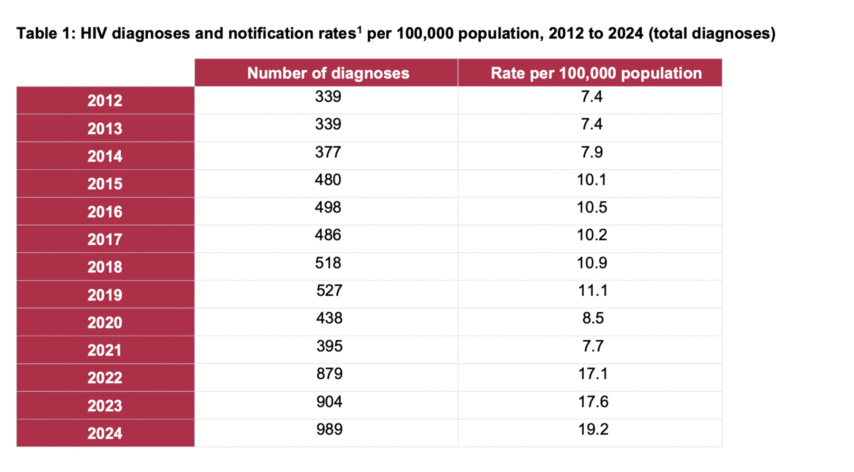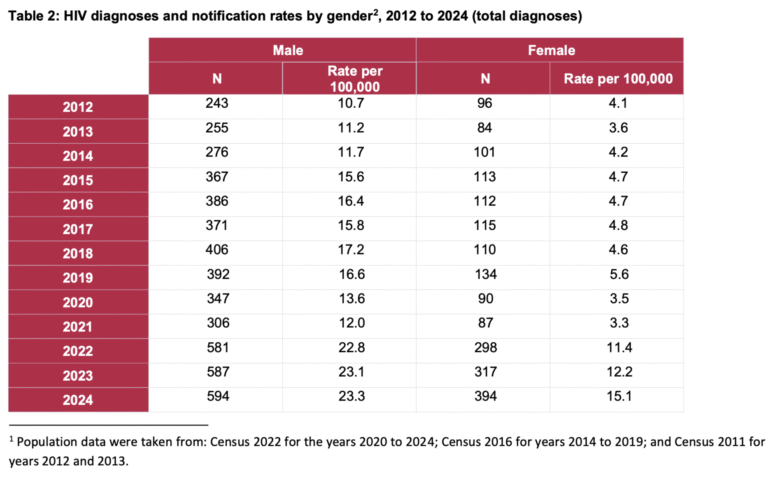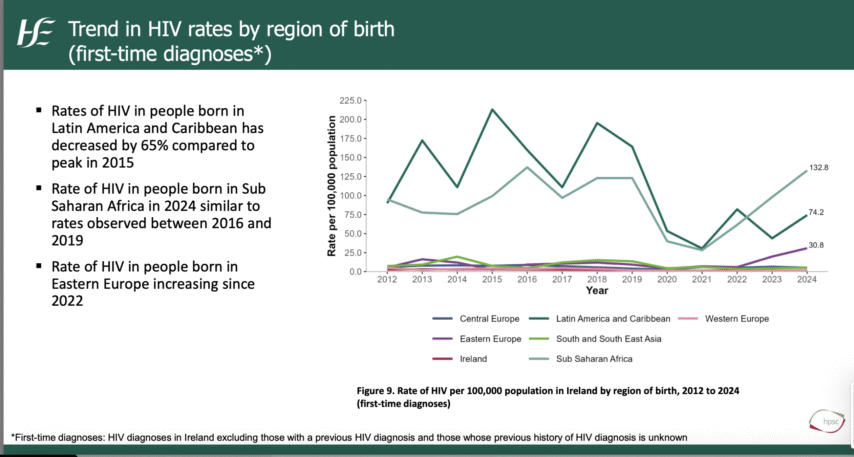The rate of HIV diagnoses in Ireland last year was the second highest in the EU per capita, according to new figures. According to a HSPC report out today, the majority of first-time diagnoses last year (74%) were among people born outside Ireland. Of those born outside of Ireland the probable country where they acquired their infection was outside Ireland for 39%, Ireland for 30%, and unknown for 31%.
23% of first-time diagnoses last year were among people born in Ireland, while 3% were marked as unknown. The majority of diagnoses (67%) were in men, with the rate twice as high as among women. Gay, bisexual and other men who have sex with men (gbMSM) continue to be a key population affected by HIV, the report states.
Overall rates among heterosexuals remain low. Rates among heterosexuals remained relatively stable from 2012 to 2019, declined during the pandemic years, and have increased again during the post- pandemic period, particularly for heterosexual women.
Higher HIV rates were seen among both men and women born outside Ireland. 97 people were diagnosed with late-stage HIV infection in 2024, representing 41% of first-time all diagnoses.
Among first time diagnoses, 52 (22%) were diagnosed with recent infection. The largest number of late-stage infections were in men, with those aged 50+ years having the highest proportion diagnosed late.
According to the report, the largest number of recent infections were in men and (gbMSM); Those aged 20-29 years and those born in Latin America and Caribbean had highest proportion diagnosed with recent infection
Rates of HIV in people born in Latin America and Caribbean has decreased by 65% compared to peak in 2015, the report released today said. The rate of HIV in people born in Sub Saharan Africa in 2024 is similar to rates observed between 2016 and 2019, whilst the rate of HIV in people born in Eastern Europe has been increasing since 2022.
239 new cases of HIV were recorded in 2024, according to the report released by the Health Protection Surveillance Centre (HPSC).
It is the first time that the number of new cases has exceeded 200 since the Covid crisis, with health officials recording a rate of 4.6 per 100,000 people for first-time diagnoses.
According to the HPSC, 989 cases were recorded here last year, affecting 594 men and 394 women.
It comes as a new report from the European Centre for Disease Prevention and Control (ECDC) and the World Health Organisation (WHO) found that Ireland has the second highest rate of overall HIV diagnoses among 30 countries, with 18.8 per 100,000 people being significantly higher than the European average of 5.3 per 100,000.
The majority of diagnoses were among people born outside of Ireland, and of this group, 39 per cent were likely to have acquired their infection outside of Ireland, while 30 per cent were thought to have acquired the infection here. For a further 31 per cent, the HSPC said the origin was unknown.
Dr John Gilmore, assistant professor in the UCD school of medicine, midwifery and health systems, responding to the report, said: “Ongoing rates of HIV transmission are deeply concerning, particularly at a time when we are closer than ever to ending new HIV transmissions.”
Information released to a reader of Gript under a Freedom of Information request earlier this year showed that the number of notifications to the HSE Health Protection Surveillance Centre (HPSC) of persons diagnosed with HIV in the Irish state had risen between 2022 and 2024.
That represented an increase of 16.4% over the two-year period. Significantly, there were just 339 cases notified in 2012 as can be found in the overall data gathered by the HPSC – meaning that the number of HIV cases trebled over the course of 12 years.
Journalist Paddy O’Gorman has previously written of the HSE’S public health campaign called ‘You, Me and HIV’ which it describes as “a new nationwide campaign aimed at addressing misconceptions around HIV and help reduce the stigma”.
Dr Matt Treacy previously wrote that the statistics provided to the reader of Gript confirm one of the main points made by Paddy O’Gorman: that the vast majority of cases of HIV here are cases involving people who have come to live in the Irish state from overseas.
A report from the Public Health Department of St. Finbarr’s hospital in Cork which found that of 509 Ukrainian refugees notified as “living with HIV” that 287 were women. This had accounted for more than a doubling of the average monthly notifications since 2022.
Friday’s report shows that rates among men are trending toward pre-pandemic levels, while rates among women have increased compared to pre-pandemic levels, slightly narrowing the gap. The rate in heterosexual women was 3.3 per 100,000 and heterosexual men was 2.7 per 100,000 in 2024.




